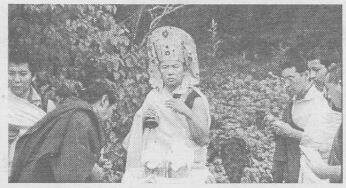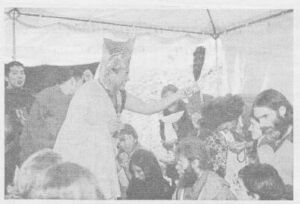| The following article is from the Spring, 2003 issue of the Snow Lion Newsletter and is for historical reference only. You can see this in context of the original newsletter here. |
BY KATHY WESLEY
Woodstock, NY—In the basement of a Buddhist monastery in the Catskills, with soft rock music playing on a radio in the background, David Fischer tussles with a challenge of metaphysical proportions.
"We want to make sure the table is at the right height for the seat," says Mr. Fischer, rubbing his hand along the smooth-sanded poplar wood. "The cushion will be 10 inches high and there will be an extra puja table placed on top of this one. We just want to make sure it all comes together for His Holiness."
Figuring out how to harmonize the two components of a traditional Tibetan teaching throne for His Holiness the 17th Karmapa, Ogyen Trinley Dorje, is not the only activity going on this day at Karma Triyana Dharmachakra, His Holiness' seat in America.

Above photo: His Holiness Karmapa consecrating the KTD grounds. His Eminence Jamgong Kangtrul Rinpoche is to His Holiness' right. Tenzin Chonyi, Dzogchen Ponlop Rinpoche and Bardor Tulku Rinpoche are to His Holiness' left. (Summer of 1980.)
Upstairs, Shrinekeeper Elaine White is helping clean the main shrine room for the arrival of dozens of Sherpa tribes people from the New York City area, who are coming to the mountains to celebrate Tibetan New Year.
"[KTD Abbot] Khenpo Karthar Rinpoche will be giving a long-life empowerment here for the Sherpas," says Ms. White. "This is a major cultural event for the Sherpa community. They come here and do their traditional dances and songs. It's a joyful event."
Elsewhere on the site, KTD staffers are proofreading the six-month teaching schedule for 2003, preparing a program that will include teachings by Traleg Rinpoche, Khenchen Thrangu Rinpoche, Khenpo Tsultrim Gyamtso, and Mingyur Rinpoche—all of them major teachers of the Karma Kagyu tradition.
In the kitchen of the old guest house, cooks are preparing lunch for some of the 20 permanent staff members; in the Namse Bangdzo Bookstore, Peter Van Deurzen and Basia Majewska are processing a major order of Tibetan statues and thankas for sale to Buddhist practitioners.
And in the back of the shrine room, a young dharma student in sweat pants and a T-shirt is working away at the polished hardwood floor, performing dozens of prostrations in an ancient ritual of purification and devotion.
In many ways, says Tenzin Chonyi, the Tibetan-born president of KTD, the American monastery is a reflection of the activities of His Holiness, who is himself considered an embodiment of the enlightened activity of all buddhas.
A Home for American Dharma
Nearly 30 years have passed since His Holiness the 16th Karmapa, Rangjung Rigpe Dorje, first set foot on the North American continent. Since that day in 1974, the Gyalwa Karmapa's activity has been instrumental in the development of Tibetan Buddhism in the West, Mr. Chonyi says.

The 16th Karmapa giving blessings white walking (Summer of 1980)
"Through the inspiration of His Holiness, great teachers like the Very Ven. Kalu Rinpoche and Chogyam Trungpa Rinpoche came to this country and planted the seeds of the Kagyu dharma here," Mr. Chonyi says. "The many Shambhala centers founded by Chogyam Trungpa Rinpoche and the many dharma centers founded through Kalu Rinpoche The 16th Karmapa giving blessings white walking (Summer of 1980) are all part of the great blessing and activity of His Holiness." Karma Triyana Dharmachakra, created in 1976 in New York City, was the first center under His Holiness' direct guidance, Mr. Chonyi says. The organization moved to the slopes of Mount Guardian in 1978, when a patron purchased the former Meads House and gave it to KTD.
In the years since then, through the efforts of resident teachers Ven. Bardor Tulku Rinpoche and Khenpo Karthar Rinpoche, KTD has helped establish more than 40 practice centers in Canada, the United States and South America. It also has built, mostly with volunteer labor, a traditionally styled Tibetan monastic temple on the road between Mount Guardian and Overlook Mountain.
"KTD is like the root and the trunk, and these many centers, including those in Canada and. Brazil, Venezuela and Colombia, are like the branches of this great tree," Mr. Chonyi says.
Those efforts are visible in the spectacular hand-painted wonder of the main KTD shrine room, decorated by the full-color artistry of Tinley Chojor, a renowned temple painter. The shrine room houses an eleven-foot-tall image of Buddha Shayamuni and four-foot-tall images of Guru Rinpoche, White Tara, Manjushri, and Vajrasattva. A large stupa containing relics of the 16th Karmapa, who passed away in 1981, and a statue of the 16th Karmapa are also present, as is a complete collection of Buddhist scriptures in the Tibetan language.
The effect of this single room on visitors, says Ms. White, is enormous.
"The minute someone opens the shrine room door and sees the room for the first time, there is, for many people, an intense generation of devotion and a wish to know more about who His Holiness Karmapa is, and what Buddhism is," she says.
This strong feeling, she adds, brings the visitors back again and again—bringing along their friends and relatives.. "Sometimes, they don't even know why; they just want to come back," Ms. White says. "Sometimes, they cry; sometimes they ask questions; sometimes they just sit in the silence—even if we are in the room busy working. They say they feel the silence more here than anywhere else."
Even non-Buddhists are moved by visits to the monastery shrine room, which has been open to tourists on weekends since its altar pieces were installed in 1992.
"There are people who, through a previous karmic connection, upon seeing [the statues of] His Holiness and the Buddha, have a seed planted for them to go on the path of dharma," says Tom Schmidt, director of operations for KTD. "There are other people who may not necessarily have a connection, but seeing the shrine room opens in them a reverence and respect for Tibetan Buddhism, even if it is not their chosen path."
A Fountain of His Holiness Karmapa's Activity
The monastery is not completed, as the traditional sangha residence structure and courtyard have yet to be built. But Mr. Schmidt says the place still evokes a strong response in visitors. This happens, he says, because KTD is a container for the activity of His Holiness—both the 16th Karmapa and his reincarnation, the 17-year-old 17th Karmapa, who was born in Tibet and escaped to India in 2000.
"I think it opens people on some subtle level, because of the authenticness of the place," Mr. Schmidt says.
The monastery temple is not the only example of His Holiness' activity on the 23-acre site at KTD. Mr. Schmidt says the organization at KTD—housed in the monastery temple and guesthouse—has been a steady fountain of dharma activity since it was founded.
"In some ways, the place hasn't changed much since I came here in 1978," says Mr. Schmidt. "On the other hand, the activity here has never leveled off. It is still climbing. The monastery itself is still being completed, and we're getting ready for His Holiness [the 17th Karmapa] to return."
Because KTD is considered His Holiness's third most important seat—the first is his ancient home at Tolong Tsurphu Monastery near Lhasa in Tibet, and the second is Rumtek Monastery in Sikkim, northern India—great Kagyu masters make a point to visit it and give teachings there.
"As students of His Holiness, the great lamas teach here, not just for the benefit of sentient beings, but as service to their guru," Mr. Schmidt says. "The previous Jamgon Kongtrul Rinpoche taught here every year to fulfill His Holiness' wishes. I remember one year when we gave him an offering for teaching and he gave it back to us, saying, 'This is His Holiness' monastery, and because I am inseparable from His Holiness, this is my monastery, too.'"
KTD also is home to the Namse Bangdzo Bookstore, as well as the Karma Kagyu Institute, an educational program; Karma Thegsum Choyang Music, a recording project; and Karma Rinchen Tongdrol Video, which is making video teachings available to the public. The organization also is the center for website development. "In terms of technical development, KTD is already taking an important role in aiding His Holiness' activity in the world," Mr. Schmidt says.
Waiting for a Universal Teacher
As Tibetan Buddhism enters the next phase in its transition from Asia to the West, the monastery at KTD will continue to be part of His Holiness' activities. Mr. Chonyi, who recently spent three months with His Holiness the 17th Karmapa in India, says that the young Karmapa already is having a powerful effect on people in India.
"Everywhere he goes, His Holiness is being sought out by pilgrims who seek his blessing," Mr. Chonyi says. "People from India, Nepal, Ladakh, even Mustang—all the countries of the Himalayan region—have come to see him. We hope to bring this same benefit to people all over the world."
Mr. Chonyi says KTD is waiting with anticipation for the Indian government to give His Holiness permission to travel abroad, at which time he plans to invite His Holiness to return to visit his monastery in America.
"His Holiness' activity here has been great, and we hope to enhance this activity by his arrival in America," Mr. Chonyi says. "He is a universal teacher, and should not be secluded in just one place. He has disciples all over the world, and his activity has pervaded every place where there is freedom of religion."
Even though there have been some challenging times in the development of His Holiness' seat in North America, Mr. Schmidt says he remains inspired by what's happened on the mountain in the Catskills.
"When the previous Kalu Rinpoche was here in 1982, he told us that working for and building the monastery was not like what Milarepa did—he said it was the same as what Milarepa did," Mr. Schmidt says.
Rinpoche went on to say that of course he was not a teacher like [Milarepa's master] Marpa, and that we were not students like Milarepa, but we were doing the same thing that Milarepa did," Mr. Schmidt says. "It was all Ngondro [preliminary practice] and purification for us."
That sentiment probably would be echoed down in the basement of the monastery, where cabinetmaker David Fischer carefully sands the Asian-carved snow lions on the throne and speaks with excited anticipation about the deep red paint and gold leaf what will adorn it.
And will his job be finished then?
"Not quite," he says, eyeing the throne.
Unless His Holiness has another method for ascending the throne, says Mr. Fischer, "he's going to need some stairs."

